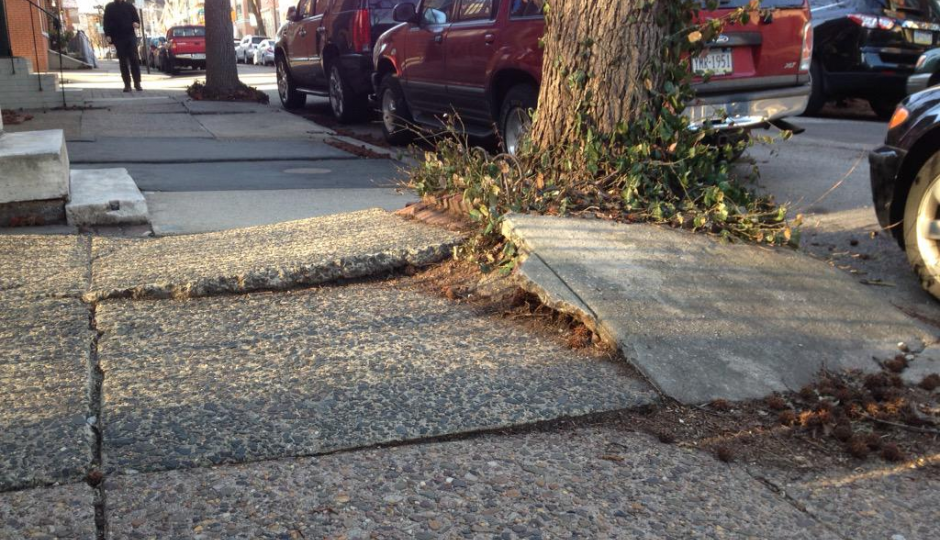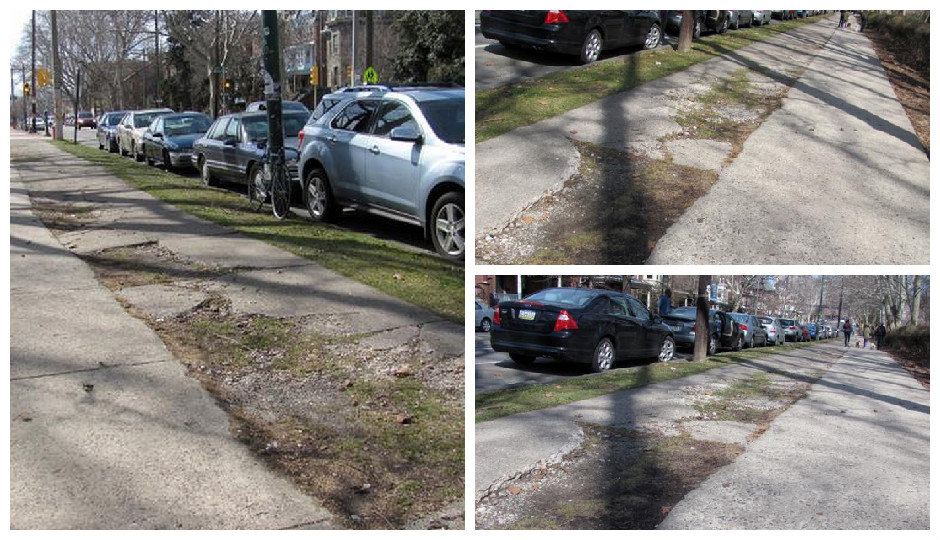Lots of Philadelphia Sidewalks Are in Horrible Shape — How to Fix Them?

A big tripping hazard on 24th Street. | Photo courtesy of reader @philavore.
Walking around Philly, it’s hard to miss the cracked sidewalks, dissolving curbs and tectonic-plate-like concrete slabs converging on top of one another, causing pedestrians to stumble and stroller wheels to jam. And who is to blame for our sidewalk madness? Not the city. Not this time. Sidewalk maintenance is the responsibility of individual property owners. Pennsylvania law has required owners of the property abutting a sidewalk to maintain its good condition since 1891, or else, risk fines and potential personal injury lawsuits. There’s a city ordinance in Section 11-505 that says much the same thing:
The sidewalks of the all public streets, and the roadways and sidewalks of all private streets, shall be graded, curbed, paved and kept in repair at the expense of the owners of the land fronting thereon, except as otherwise provided in this section.
And how’s that working out in the real world? Not well, not well at all; particularly outside of Center City, where busted, tree-root shimmed and all-but-obliterated sidewalks are distressingly common. Philadelphia’s walkability is one of its chief strengths—but not on those stretches where sidewalks are in gross disrepair.
“It’s not just homeowners, it’s major neighborhood institutions,” said Lauren Vidas, the chair of the South of South Neighborhood Association. One church in Graduate Hospital had sidewalks that were beaten into piles of debris, Vidas said, citing just one example in SOSNA’s community.
The group got in touch with Councilman Kenyatta Johnson, who reached out to the Streets Department to inquire about fines. But, as Vidas explains, part of the problem is that city fees for poorly maintained Philadelphia sidewalks are not nearly steep enough to convince many property owners to pay for the costly repairs. Replacing a square slab of sidewalk can run from $100 to $200 apiece, adding up to more than a thousand for a stretch of concrete. SOSNA also tried writing letters to property owners, informing them that sidewalks were their obligation under the law. That also didn’t work.
In many other cities, citizens aren’t forced to go it alone on costly sidewalk repairs. Chicago’s code requires the city — not property owners — to maintain the cracks and holes of sidewalks, or else be liable (sidewalk injury cases cost the city $6 million in payouts between 2008 and 2013). On top of that, Chicago has a 50-year-old “shared sidewalks” program that allows citizens to take the initiative with fixing their sidewalks, rather than waiting for the backlogged requests lodged with the city. Any citizen who pays for sidewalk repairs through a private contractor can have the city foot half the bill.
But municipal maintenance isn’t a perfect answer, not given the strapped budgets of many cities. Like Philly, Los Angeles used to require property owners to fix public sidewalks on their property until the 1970s, when the city changed its code after residents complained that city-owned trees were the source of many of the problems. The city assumed responsibility for repairs, bolstered by federal funding, until the money ran out and nobody was fixing the sidewalks. As of a few years ago, 42 percent of LA’s sidewalks were in poor condition. That led disabled residents to sue the city. The case settled this week, with the city of LA announcing it will spend $1.4 billion—that’s billion with a B—over the next 30 years repairing sidewalks.
In Memphis, City Council is now considering a program to provide public assistance for sidewalk repairs for residents who are disabled or impoverished. Austin now has shared responsibility for its sidewalks. And other cities, including Atlanta, are considering shifting some responsibility away from residents.
Given that Philadelphia can’t find enough money to pay for its schools, don’t expect the city to change its codes on sidewalks and absorb homeowners’ costs. Over the next five years, the city’s Capital Improvement Program calls for just $12.5 million for upgrading Philadelphia sidewalks, curbs, lighting, landscaping and parking within its commercial corridors. That’s a drop in the bucket.

The 4300 block of Baltimore Avenue | Photo courtesy of @phillybikes
What other options are there? SOSNA is looking for ways to incentivize repairs and create a mechanism for sharing the costs of sidewalk maintenance. The group has floated the idea of creating a Top 10 list of sidewalk offenders within the neighborhood, going to contractors to see if they could defray a small portion of the cost, then, approaching those property owners with a prepackaged deal for repairing the sidewalks that’s cheaper than market rate. “It’s not a shaming thing,” says Vidas. “It’s about targeting resources for the places in neighborhoods that are most unsafe for folks.”
Some cities, such as Minneapolis, give property owners the ability to “finance” sidewalk repairs. A city-selected contractor performs the work, and the property owner pays off the costs over time with slightly higher property taxes until the debt is paid. A program like that could help cash-poor property owners meet their maintenance obligations over time.
On the tough love side, New York gives property owners with busted sidewalks 45 days to fix them. If the work doesn’t get done, the city has the right to replace the sidewalk and tack the costs onto the property tax bill. Would that fly in Philly? It probably depends on which property owners were getting socked.
A comprehensive fix for busted Philadelphia sidewalks would probably require both approaches: rigid enforcement for those property owners financially capable of fixing the sidewalks, and assistance for those property owners without cash to do the job themselves.